Lübeck
Lübeck | |
|---|---|
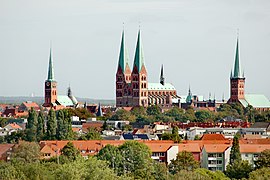     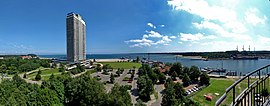 Clockwise from top: skyline with St Jacob's, St Mary's, and St Peter's, Trave and Lübeck Cathedral in winter, Trave with St Mary's and St Peter's, mouth of the Trave in Travemünde with Maritim high-rise and Passat, Lübeck Cathedral and Sacred Heart Church, Holsten Gate | |
 Flag | |
show Location of Lübeck | |
 Lübeck | |
| Coordinates: 53°52′11″N 10°41′11″E / 53.86972°N 10.68639°ECoordinates: 53°52′11″N 10°41′11″E / 53.86972°N 10.68639°E | |
| Country | Germany |
| State | Schleswig-Holstein |
| District | Urban district |
| Subdivisions | 35 Stadtbezirke |
| Government | |
| • Mayor | Jan Lindenau (SPD) |
| • Governing parties | SPD / CDU |
| Area | |
| • Total | 214.13 km2 (82.68 sq mi) |
| Elevation | 13 m (43 ft) |
| Population (2020-12-31)[1] | |
| • Total | 215,846 |
| • Density | 1,000/km2 (2,600/sq mi) |
| Time zone | UTC+01:00 (CET) |
| • Summer (DST) | UTC+02:00 (CEST) |
| Postal codes | 23501−23570 |
| Dialling codes | 0451, 04502 |
| Vehicle registration | HL[2] |
| Website | www.luebeck.de |
| UNESCO World Heritage Site | |
|---|---|
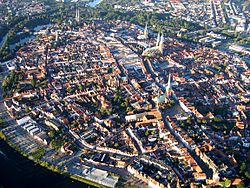 Aerial view of the old town | |
| Criteria | Cultural: iv |
| Reference | 272 |
| Inscription | 1987 (11th Session) |
| Area | 81.1 ha |
| Buffer zone | 693.8 ha |
Lübeck (German: [ˈlyːbɛk] (![]() listen); Low German also Lübeek; Danish: Lybæk [ˈlyˌpek]), officially the Hanseatic City of Lübeck (German: Hansestadt Lübeck), is a city in Northern Germany. With around 217,000 inhabitants, Lübeck is the second-largest city on the German Baltic coast and in the state of Schleswig-Holstein, after its capital of Kiel, and is the 35th-largest city in Germany. The city lies in Holstein, northeast of Hamburg, on the mouth of the River Trave, which flows into the Bay of Lübeck in the borough of Travemünde, and on the Trave's tributary Wakenitz. The city is part of the Hamburg Metropolitan Region, and is the southwesternmost city on the Baltic, as well as the closest point of access to the Baltic from Hamburg. The port of Lübeck is the second-largest German Baltic port after the port of Rostock. The city lies in the Northern Low Saxon dialect area of Low German.
listen); Low German also Lübeek; Danish: Lybæk [ˈlyˌpek]), officially the Hanseatic City of Lübeck (German: Hansestadt Lübeck), is a city in Northern Germany. With around 217,000 inhabitants, Lübeck is the second-largest city on the German Baltic coast and in the state of Schleswig-Holstein, after its capital of Kiel, and is the 35th-largest city in Germany. The city lies in Holstein, northeast of Hamburg, on the mouth of the River Trave, which flows into the Bay of Lübeck in the borough of Travemünde, and on the Trave's tributary Wakenitz. The city is part of the Hamburg Metropolitan Region, and is the southwesternmost city on the Baltic, as well as the closest point of access to the Baltic from Hamburg. The port of Lübeck is the second-largest German Baltic port after the port of Rostock. The city lies in the Northern Low Saxon dialect area of Low German.
Lübeck is famous for having been the cradle and the de facto capital of the Hanseatic League. Its city centre is Germany's most extensive UNESCO World Heritage Site. While the city's symbol is the Holsten Gate, Lübeck's skyline is dominated by the seven towers of its five main churches St Mary's, Lübeck Cathedral, St Jacob's (), St Peter's (), and St Giles'. The cathedral, finished around 1230, was the first large brickwork church in the Baltic region. St Mary's, finished in 1351, served as model for the other Brick Gothic churches around the Baltic. It has the second-tallest two-steeples façade after Cologne Cathedral, which only surpassed it in 1880, the tallest brick vault, and is the second-tallest brickwork structure after St Martin's in Landshut. Travemünde is a famous seaside resort, and its Maritim high-rise serves as the second-tallest lighthouse in the world at 114 metres (374 ft) high. Lübeck is also known for Lübeck Marzipan.
History[]

Humans settled in the area around what today is Lübeck after the last Ice Age ended about 9700 BCE. Several Neolithic dolmens can be found in the area.
Around 700 CE, Slavic peoples started moving into the eastern parts of Holstein, an area previously settled by Germanic inhabitants who had moved on in the Migration Period. Charlemagne, whose efforts to Christianise the area were opposed by the Germanic Saxons, expelled many of the Saxons and brought in Polabian Slavs allies. Liubice (the place-name means "lovely") was founded on the banks of the River Trave about 4 km (2.5 mi) north of the present-day city-center of Lübeck. In the 10th century, it became the most important settlement of the Obotrite confederacy and a castle was built. In 1128, the pagan Rani from Rügen razed Liubice.

In 1143, Adolf II, Count of Schauenburg and Holstein, founded the modern town as a German settlement on the river island of Bucu. He built a new castle, first mentioned by the chronicler Helmold as existing in 1147. Adolf had to cede the castle to the Duke of Saxony, Henry the Lion, in 1158. After Henry's fall from power in 1181, the town became an Imperial city for eight years.[citation needed] Emperor Barbarossa (reigned 1152–1190) ordained that the city should have a ruling council of 20 members. With the council dominated by merchants, pragmatic trade interests shaped Lübeck's politics for centuries. The council survived into the 19th century. The town and castle changed ownership for a period afterwards and formed part of the Duchy of Saxony until 1192, of the County of Holstein until 1217, and of the kingdom of Denmark until the Battle of Bornhöved in 1227.
Hanseatic city[]
Around 1200, the port became the main point of departure for colonists leaving for the Baltic territories conquered by the Livonian Order, and later, by the Teutonic Order. In 1226, Emperor Frederick II elevated the town to the status of an Imperial free city, by which it became the Free City of Lübeck.
| Goods | Principal origin | Imports | Exports | Total |
|---|---|---|---|---|
| Cloth | Flanders | 120.8 | 39.7 | 160.5 |
| Fish | Scania | 64.7 | 6.1 | 70.8 |
| Salt | Luneburg | - | 61.6 | 61.6 |
| Butter | Sweden | 19.2 | 6.8 | 26 |
| Skins, furs | Russia, Sweden | 13.3 | 3.7 | 17 |
| Grain | Prussia | 13 | 0.8 | 13.8 |
| Wax | Russia, Prussia | 7.2 | 5.8 | 13 |
| Beer | Wendish towns | 4.1 | 1.9 | 6 |
| Copper | Sweden, Hungary | 2.2 | 2.4 | 4.6 |
| Iron | Sweden, Hungary | 2.4 | 2.2 | 4.6 |
| Oil | Flanders | 2.7 | 1.5 | 4.2 |
| Flax | Livonia, North Germany | 0.4 | 3 | 3.4 |
| Foodstuffs | passim | 2.2 | 1.2 | 3.4 |
| Silver | Sweden | 0.7 | 2 | 2.7 |
| Wine | Rhineland | 1.3 | 0.9 | 2.2 |
| Various | 39.9 | 16.6 | 56.5 | |
| Unclassified | 41 | 49 | 90 | |
| Total (rounded) | 338.9 | 206.9 | 545.8[3] |
In the 14th century, Lübeck became the "Queen of the Hanseatic League", being by far the largest and most powerful member of that medieval trade organization. In 1375, Emperor Charles IV named Lübeck one of the five "Glories of the Empire", a title shared with Venice, Rome, Pisa, and Florence.
| Arrivals | % | Origin, destination | Departures | % |
|---|---|---|---|---|
| 289 | 33.7 | Mecklenburg-Pomerania | 386 | 42.3 |
| 250 | 28.8 | Skania | 207 | 22.8 |
| 145 | 16.8 | Prussia | 183 | 20.1 |
| 96 | 11.2 | Sweden | 64 | 7 |
| 35 | 4.3 | Livonia | 43 | 4.7 |
| 28 | 3.2 | Fehmarn | 27 | 3 |
| 12 | 1.6 | Bergen | - | - |
| 3 | 0.4 | Flanders | 1 | 0.1 |
| 858 | 100 | 911 | 100[4] |
Several conflicts about trading privileges resulted in fighting between Lübeck (with the Hanseatic League) and Denmark and Norway – with varying outcome. While Lübeck and the Hanseatic League prevailed in conflicts in 1435 and 1512, Lübeck lost when it became involved in the Count's Feud, a civil war that raged in Denmark from 1534 to 1536. Lübeck also joined the pro-Lutheran Schmalkaldic League of the mid-16th century.
| Butter | Copper | |||||||
|---|---|---|---|---|---|---|---|---|
| Year | Lübeck | % | Danzig | % | Lübeck | % | Danzig | % |
| 1368 | 2000 | 460 | ||||||
| 1369 | 900 | 530 | ||||||
| 1400 | 247 | 45 | ||||||
| 1492 | 76 | 1250 | ||||||
| 1493 | - | 2849 | ||||||
| 1494 | - | 1906 | ||||||
| 1495 | - | 435 | ||||||
| 1559 | 1254 | 89 | 150 | 11 | - | |||
| 1572 | 1350 | 74 | 252 | 14 | 564 | 94 | 3 | 0.5 |
| 1582 | 1224 | 86 | 105 | 10 | 803 | 85 | 59 | 6.2 |
| 1583 | 1133 | 77 | 165 | 11 | 2153 | 70 | 122 | 4 |
| 1584 | 909 | 74 | 177 | 14 | 2415 | 69 | 49 | 1.4 |
| 1591 | 742 | 74 | 170 | 17 | 1487 | 74 | 247 | 12 |
| 1600 | - | - | 56 | 5 | - | - | 1 | 0 |
| 1610 | 64 | 47 | 7 | 5 | 1411 | 83 | 18 | 1.1 |
| 1620 | 659 | 76 | 50 | 6 | 7434 | 86 | 12 | 0.1[6] |
After its defeat in the Count's Feud, Lübeck's power slowly declined. The city remained neutral in the Thirty Years' War of 1618–1648, but the combination of the devastation from the decades-long war and the new transatlantic orientation of European trade caused the Hanseatic League – and thus Lübeck with it – to decline in importance. However, even after the de facto disbanding of the Hanseatic League in 1669, Lübeck still remained an important trading town on the Baltic Sea.

Old traditions, new challenges[]
Franz Tunder was the organist in the Marienkirche. It was part of the tradition in this Lutheran congregation that the organist would pass on the duty in a dynastic marriage.[clarification needed] In 1668, his daughter Anna Margarethe married the great Danish-German composer Dieterich Buxtehude, who was the organist at the Marienkirche in Lübeck until at least 1703. Some of the greatest composers of the day came to the church to hear his renowned playing.
In the course of the war of the Fourth Coalition against Napoleon, troops under Marshal Jean Baptiste Bernadotte (who would later become King of Sweden) occupied Lübeck after a battle against Prussian General Gebhard Blücher on 6 November 1806 due to the latter's illegal use of the city as a fortress, in violation of Lübeck's neutrality, following the French pursuit of his corps after the Battle of Jena-Auerstadt. Under the Continental System, the State bank went into bankruptcy. In 1811, the French Empire formally annexed Lübeck as part of France; the anti-Napoleonic allies liberated the area in 1813, and the Congress of Vienna of 1815 recognised Lübeck as an independent free city. The city became a member of the German Confederation (1815–1866) the North German Confederation (1866–1871) the German Empire (1871–1918) and the Weimar Republic (1919–1933).

During the Franco-Prussian War, the battalion de Fusilier of Lübeck was part of the "2nd Hanseatic Infantry Regiment No. 76". On the day of the Battle of Loigny the commander of the 17th Division, Hugo von Kottwitz, of the morning advanced in front of the Fusilier battalion of the regiment, urging them to "commemorate the bravery of the Hanseatic League". his attack in the north while the other battalions turned towards Loigny. This shock surprised the French so much that they were invaded by their flank. They fled to the Fougeu place and were kicked out of this. The battle was to become the founding myth of the last Lübeck regiment, 3rd Hanseatic Infantry Regiment No. 162, which was founded in 1897. When the battalion commander returned to Lübeck with his battalion, he was appointed regimental commander.
Under the Third Reich (1933–1945) the Nazis passed the Greater Hamburg Act, which incorporated the city of Lübeck into the Schleswig-Holstein province of Prussia, effective April 1, 1937. It thereby lost its status as an independent constituent state.
Writer Thomas Mann was a member of the Mann family of Lübeck merchants. His well-known 1901 novel Buddenbrooks made readers in Germany (and later worldwide, through numerous translations) familiar with the manner of life and mores of the 19th-century Lübeck bourgeoisie.

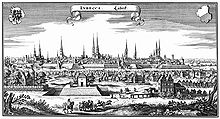
During World War II (1939–1945), Lübeck became the first German city to suffer substantial Royal Air Force (RAF) bombing. The attack of 28 March 1942 created a firestorm that caused severe damage to the historic centre. This raid destroyed three of the main churches and large parts of the built-up area; the bells of St Marienkircke plunged to the stone floor.[7] Germany operated a prisoner-of-war camp for officers, Oflag X-C, near the city from 1940 until April 1945. The British Second Army entered Lübeck on 2 May 1945 and occupied it without resistance.
On 3 May 1945, one of the biggest disasters in naval history occurred in the Bay of Lübeck when RAF bombers sank three ships: the SS Cap Arcona, the SS Deutschland, and the SS Thielbek – which, unknown to them, were packed with concentration-camp inmates. About 7,000 people died.
Lübeck's population grew considerably, from about 150,000 in 1939 to more than 220,000 after the war, owing to an influx of ethnic German refugees expelled from the so-called former eastern provinces of Germany in the Communist Bloc. Lübeck remained part of Schleswig-Holstein after World War II (and consequently lay within West Germany). It stood directly on what became the inner German border during the division of Germany into two states in the Cold War period. South of the city, the border followed the path of the river Wakenitz, which separated the Germanys by less than 10 m (33 ft) in many parts. The northernmost border crossing was in Lübeck's district of Schlutup. Lübeck spent decades restoring its historic city centre. In 1987, UNESCO designated this area a World Heritage Site.
Lübeck became the scene of a notable art scandal in the 1950s. Lothar Malskat was hired to restore the medieval frescoes of the cathedral of the Marienkirche, which were discovered after the cathedral had been badly damaged during World War II. Instead, he painted new works, which he passed off as restorations, fooling many experts. Malskat later revealed the deception himself. Günter Grass featured this incident in his 1986 novel The Rat.

On the night of 18 January 1996, a fire broke out in a home for foreign refugees, killing 10 people and severely injuring more than 30 others, mostly children. Most of the shelter's inhabitants thought it was a racist attack, as they stated that they had encountered other overt hostility in the city.[8] The police and the local court were criticized at the time for ruling out racism as a possible motive before even beginning preliminary investigations.[9] But by 2002, the courts found all the Germans involved[10] not guilty; the perpetrators have not been caught.
In April 2015, Lübeck hosted the G7 conference.[11]
Demographics[]
In 2015, the city had a population of 218,523. The largest ethnic minority groups are Turks, Central Europeans (Poles), Southern Europeans (mostly Greeks and Italians), Eastern Europeans (e.g. Russians), Arabs, and several smaller groups.
Population development since 1227:
| Year | Pop. | ±% |
|---|---|---|
| 1227 | 6,000 | — |
| 1400 | 17,200 | +186.7% |
| 1600 | 22,570 | +31.2% |
| 1708 | 19,978 | −11.5% |
| 1871 | 39,743 | +98.9% |
| 1900 | 82,098 | +106.6% |
| 1910 | 98,656 | +20.2% |
| 1925 | 120,788 | +22.4% |
| 1939 | 154,811 | +28.2% |
| 1950 | 238,276 | +53.9% |
| 1956 | 228,670 | −4.0% |
| 1961 | 236,477 | +3.4% |
| 1970 | 239,657 | +1.3% |
| 1975 | 232,270 | −3.1% |
| 1980 | 220,588 | −5.0% |
| 1990 | 214,758 | −2.6% |
| 2000 | 213,399 | −0.6% |
| 2010 | 210,513 | −1.4% |
| 2015 | 216,253 | +2.7% |
| 2019 | 217,346 | +0.5% |
| source:[12][circular reference] | ||
Population structure:[13]
| Rank | Nationality | Population (31.12.2020) |
|---|---|---|
| 1 | 4,077 | |
| 2 | 2,733 | |
| 3 | 2,496 | |
| 4 | 1,228 | |
| 5 | 1,191 | |
| 6 | 998 | |
| 7 | 983 | |
| 8 | 724 | |
| 9 | 709 |
Tourism[]
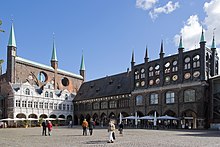



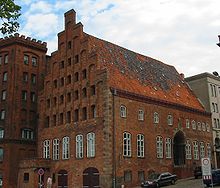
In 2019 Lübeck reached 2 million overnight stays. Lübeck is famous for its medieval City Centre with the Churches, the Holstentor, its small alleys and so much more. Lübeck has been called "Die Stadt der 7 Türme" (The City of seven Towers) due to its seven prominent church towers.
A typical visit in Lübeck includes a walk through the medieval city centre to see the Holstentor, the famous Churches like St. Mary's Church, and the city hall. Lübeck is also very famous for marzipan. This almond treat has been a part of Lübeck's history since 1806, and amongst its most famous producers is "Niederegger". For many people the Niederegger coffee shop in the city centre is a significant tourist attraction: it offers more than 25 variety of pie and all things marzipan. At night time, there are many bars, clubs and restaurants to finish the day.
Also very popular is the city of Travemünde on the Baltic Sea. In summer there are thousands of people on the white sanded beach. Here you can watch the huge ferries and cruiseships coming in and leaving the port to Scandinavia.
Most tourists stay for a week and visit places nearby such as the cities of Hamburg, Schwerin, Wismar or Rostock, the seaside resorts Timmendorfer Strand, Scharbeutz, Grömitz or Boltenhagen, going on a cycling tour on the coast of the Baltic Sea, the Hansa-Park amusement park, the SeaLife Center in Timmendorf, the Island of Fehmarn, and some even on a day trip to Denmark.
Buildings[]
Much of the old town has kept a medieval appearance with old buildings and narrow streets. At one time, the town could only be entered by any of four town gates, two of which remain today, the well-known Holstentor (1478) and the Burgtor (1444).
The old town centre is dominated by seven church steeples. The oldest are the Lübeck Cathedral and the Marienkirche (Saint Mary's), both dating from the 13th and 14th centuries.
Built in 1286, the Holy Spirit Hospital at Koberg is one of the oldest existing social institutions in the world and one of the most important buildings in the city. The Holy Spirit Hospital is in parts an old-folk and nursing home. Historic parts can be visited.
Other sights include:
- The City Hall
- St. Catherine's Church, a church that belonged to a former monastery, now the Katharineum, a Latin school
- Thomas Mann's house
- Günter Grass's house
- Church of St Peter
- Church of St Lawrence, located on the site of a cemetery for people who died during the 16th-century plague
- Church of St Jacob, 1334
- Church of the Sacred Heart
- Church of St Aegidien
- the Salzspeicher, historic warehouses where salt delivered from Lüneburg awaited shipment to Baltic ports
- The City of Travemünde on the Coast of the Baltic Sea.
Like many other places in Germany, Lübeck has a long tradition of a Christmas market in December, which includes the famous handicrafts market inside the Heiligen-Geist-Hospital (Hospital of the Holy Spirit), located at the northern end of Königstrasse.
Museums[]
Lübeck has many small museums, such as the St. Anne's Museum Quarter, Lübeck, the Behnhaus, the European Hansemuseum, and the Holstentor. Lübeck Museum of Theatre Puppets is a privately run museum. Waterside attractions are a lightvessel that served Fehmarnbelt and the Lisa von Lübeck, a reconstruction of a Hanseatic 15th century caravel. The marzipan museum in the second floor of Café Niederegger in Breite Strasse explains the history of marzipan, and shows historical wood molds for the production of marzipan blocks and a group of historical figures made of marzipan.
Food and drink[]
Lübeck is famous for its marzipan industry. According to local legend, marzipan was first made in Lübeck, possibly in response either to a military siege of the city or a famine year. The story, perhaps apocryphal, is that the city ran out of all food except stored almonds and sugar, which were used to make loaves of marzipan "bread".[14] Others believe that marzipan was actually invented in Persia a few hundred years before Lübeck claims to have invented it. The best known producer is Niederegger, which tourists often visit while in Lübeck, especially at Christmas time.[15]
The Lübeck wine trade dates back to Hanseatic times. One Lübeck specialty is Rotspon (![]() listen (help·info)), wine made from grapes processed and fermented in France and transported in wooden barrels to Lübeck, where it is stored, aged and bottled.[16]
listen (help·info)), wine made from grapes processed and fermented in France and transported in wooden barrels to Lübeck, where it is stored, aged and bottled.[16]
Like other coastal North German communities, Fischbrötchen and Brathering are popular takeaway foods, given the abundance of fish varieties.
Education[]
Lübeck has three universities, the University of Lübeck, the Technical University of Applied Sciences Lübeck, and the Lübeck Academy of Music. The Graduate School for Computing in Medicine and Life Sciences is a central faculty of the University and was founded by the German Excellence Initiative. The International School of New Media is an affiliated institute of the university.
Districts[]

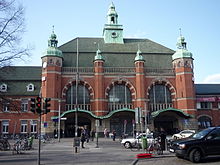


The city of Lübeck is divided into 10 zones. These again are arranged into altogether 35 urban districts. The 10 zones with their official numbers, their associated urban districts and the numbers of inhabitants of the quarters:
- 01 City centre (~ 12,000 inhabitants)
The Innenstadt is the main tourist attraction and consists of the old town as well as the former ramparts. It is the oldest and smallest part of Lübeck.
- 02 St. Jürgen (~ 40,000 inhabitants)
- Hüxtertor / Mühlentor / Gärtnergasse, Strecknitz / Rothebek, Blankensee, Wulfsdorf, Beidendorf, Krummesse, Kronsforde, Niederbüssau, Vorrade, Schiereichenkoppel, Oberbüssau
Sankt Jürgen is one of three historic suburbs of Lübeck (alongside St. Lorenz and St. Gertrud). It is located south of the city centre and the biggest of all city parts.
- 03 Moisling (~ 10,000 inhabitants)
- Niendorf / Moorgarten, Reecke, Old-Moisling / Genin
Moisling is situated in the far south-west. Its history dates back to the 17th century.
- 04 Buntekuh (~ 10,000 inhabitants)
Buntekuh lies in the west of Lübeck. A big part consists of commercial zones such as the Citti-Park, Lübeck's biggest mall.
- 05 St. Lorenz-South (~ 12,000 inhabitants)
Sankt Lorenz-Süd is located right in the south-west of the city centre and has the highest population density. The main train and bus station lie in its northern part.
- 06 St. Lorenz-North (~ 40,000 inhabitants)
- Holstentor-North, Falkenfeld / Vorwerk / Teerhof, Großsteinrade / Schönböcken, Dornbreite / Krempelsdorf
Sankt Lorenz-Nord is situated in the north-west of Lübeck. It is split from its southern part by the railways.
- 07 St. Gertrud (~ 40,000 inhabitants)
- Burgtor / Stadtpark, Marli / Brandenbaum, Eichholz, Karlshof / Israelsdorf / Gothmund
Sankt Gertrud is located in the east of the city centre. This part is mainly characterized by its nature. Many parks, the rivers Wakenitz and Trave and the forest Lauerholz make up a big part of its area.
- 08 Schlutup (~ 6,000 inhabitants)
Schlutup lies in the far east of Lübeck. Due to forest Lauerholz in its west and river Trave in the north, Schlutup is relatively isolated from the other city parts.
- 09 Kücknitz (~ 20,000 inhabitants)
North of river Trave lies Kücknitz. It is the old main industrial area of Lübeck.
- 10 Travemünde (~ 15,000 inhabitants)
- Ivendorf, Alt-Travemünde / Rönnau, Priwall, Teutendorf, Brodten
Travemünde is located in far northeastern Lübeck at the Baltic Sea. With its long beach and coast line, Travemünde is the second biggest tourist destination.
International relations[]
Lubec, Maine and Lubbock, Texas, are both named after Lübeck.
Twin towns – sister cities[]
Lübeck is twinned with:[17]
 Kotka, Finland (1969)
Kotka, Finland (1969) La Rochelle, France (1988)
La Rochelle, France (1988) Wismar, Germany (1987)
Wismar, Germany (1987) Klaipėda, Lithuania (1990)
Klaipėda, Lithuania (1990) Gotland, Sweden (1999)
Gotland, Sweden (1999)
Friendly cities[]
Lübeck also has friendly relations with:[17]
 Venice, Italy (1979)
Venice, Italy (1979) Kawasaki, Japan (1992)
Kawasaki, Japan (1992) Shaoxing, China (2003)
Shaoxing, China (2003)
Transport[]
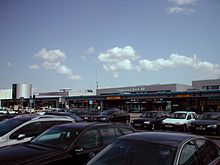
Lübeck is connected to three Main Motorways (Autobahnen). The A1 Motorway is heading north to the Island of Fehmarn and Copenhagen (Denmark) and south to Hamburg, Bremen and Cologne. The A20 Motorway is heading east to Wismar, Rostock and Szczecin (Poland) and west to Bad Segeberg and to the North Sea. The A226 Motorway starts in Central Lübeck and is heading to the north-east and the Seaport-City of Travemünde.
Lübeck has multiple train Stations. The biggest of them is Lübeck Central Station. With about 31.000 passengers per day, it's the largest station in Schleswig-Holstein. The station is most likely being served by regional rail services to Hamburg, Lüneburg, Kiel, the Island of Fehmarn and Szczecin (Poland). There are some Long-distance trains to Munich, Frankfurt a.M. and Cologne. During the summer holidays, there are many extra rail services. Till the end of 2019, Lübeck was a stop on the "Vogelfluglinie" train line from Hamburg to Copenhagen (Denmark).
Public transport by bus is organized by the Lübeck City-Traffic-Company (Lübecker Stadtverkehr). There are 40 buslines serving the city and the area around Lübeck. There are some other regional Bus services.
In Lübeck's district of Travemünde is on the Baltic Sea and has the city's main port. The Scandinavienkai (the quay of Scandinavia) has ferry routes to Malmö and Trelleborg (Sweden); Liepāja (Latvia); Helsinki (Finland) and Saint Petersburg (Russia). It is the second-biggest German port on the Baltic Sea.
Lübeck Airport is located in the south of Lübeck in the town of Blankensee. It provides regional flights to Munich and Stuttgart and some charter flights to Italy and Croatia.
Notable people[]
Religion[]

- Laurentius Surius (1522–1578), Carthusian monk[18] and hagiographer
- August Hermann Francke (1663–1727), pedagogue,[19] theologian, founded the Francke Foundations
- Johann Lorenz von Mosheim (1693–1755), Lutheran[20] church historian
- Ephraim Carlebach (1879–1936), rabbi and founder of the Higher Israelite School in Leipzig
- Joseph Carlebach (1883–1942), rabbi, victim of the Holocaust
- Felix Carlebach (1911–2008), rabbi
Politics[]

- Johann Wittenborg (1321–1363), Mayor of Lübeck, lost the Battle of Helsingborg
- Jürgen Wullenwever (c.1492–1537), burgomaster of Lübeck from 1533 to 1535
- George Wulweber, 16th-century Protestant who was tortured on the rack
- Friedrich Krüger (1819–1896), diplomat for the Hanseatic cities of Lübeck, Hamburg and Bremen
- John Rugee (1827–1894), politician in Wisconsin, USA
- Gustav Radbruch (1878–1949), legal scholar and politician
- Hermann Lüdemann (1880–1959), CDU politician
- Otto-Heinrich Drechsler (1895–1945), Mayor of Lübeck 1933 to 1937, set up the Riga ghetto
- Haim Cohn (1911–2002), Israeli jurist and politician
- Willy Brandt (1913–1992), SPD politician,[21] German chancellor
- Björn Engholm (born 1939), SPD politician
- Robert Habeck (born 1969), writer and politician of the Alliance 90/The Greens
- Birgitt Ory (born 1964), diplomat
- Beatrix von Storch (born 1971), AfD politician, former MEP
Art[]

- Benjamin Block (1631–1690), German-Hungarian Baroque[22] painter
- Sir Godfrey Kneller (1646–1723), court painter[23] of several British monarchs
- Catharina Elisabeth Heinecken (1683–1757), artist and alchemist
- Carl Heinrich von Heineken (1707–1791), art historian
- Friedrich Overbeck (1789–1869), painter[24] and head of the Nazarenes
- Johann Wilhelm Cordes (1824–1869), landscape painter
- Gotthardt Kuehl (1850–1915), painter
- Maria Slavona (1865–1931), impressionist painter, sister of Cornelia Schorer
- Erich Ponto (1884–1957), actor
- Walter D. Asmus (born 1941), theatre director
- Justus von Dohnányi (born 1960), actor
- Jonas Nay (born 1990), actor

Music[]
- Franz Tunder (1614–1667), organist and composer
- Thomas Baltzar (around 1631–1663), violinist[25] and composer
- Dieterich Buxtehude (c.1637–1707), composer and organist
- Andreas Kneller (1649–1724), composer and organist
- Friedrich Ludwig Æmilius Kunzen (1761–1817), composer
- Anja Thauer (1945–1973), cellist
Science[]

- Joachim Jungius (1587–1657), mathematician, physicist, and philosopher
- Heinrich Meibom (1638–1700), medical expert, discovered the Meibomian gland
- Hermann von Fehling (1811–1885), chemist[26]
- Robert Christian Avé-Lallemant (1812–1884), physician and research traveler
- Ernst Curtius (1814–1896), classical archaeologist[27] and historian
- Georg Curtius (1820–1885), philologist[28]
- Friedrich Matthias Claudius (1822–1869), anatomist
- James Behrens (1824–1898), entomologist[29]
- Friedrich Matz (1843–1874), archaeologist
- Friedrich Wilhelm Gustav Bruhn (1853–1927), invented the taximeter
- Cornelia Schorer (1863–1939), one of Germany's first female physicians
- Heinrich Lüders (1869–1943), orientalist and indologist
- Justus Mühlenpfordt (1911–2000), nuclear physicist
Writing[]

- Erasmus Finx (1627–1694), polyhistorian, author and church writer
- Christian Adolph Overbeck (1755–1821), mayor and poet
- Johann Bernhard Vermehren (1777–1803), romanticist and lecturer
- Emanuel Geibel (1815–1884), poet[30]
- Gustav Falke (1853–1916), author
- Heinrich Mann (1871–1950), novelist
- Thomas Mann (1875–1955), novelist, Nobel Prize for Literature in 1929
- Friedrich Ranke (1882–1950), a German medievalist, philologist, folklorist and writer
- Jörg Wontorra (born 1948), sport journalist
Sport[]
- Sandra Völker (born 1974), swimmer, won three medals at the 1996 Summer Olympics
- Marie-Louise Dräger (born 1981) five-time world champion lightweight sculler
- Tobias Kamke (born 1986) a professional tennis player
- Maximilian Munski (born 1988) rower, silver medallist at the 2016 Summer Olympics
- and

- Adam Brand (before 1692–1746), merchant and researcher
- Christian Friedrich Heinecken (1721–1725), "the infant scholar of Lübeck", a child prodigy[31]
- Kurd von Schlözer (1822–1894), diplomat and historian
- Hermann von der Hude (1830–1908), architect
- Hermann Blohm (1848–1930), shipbuilder and company founder
- Hermann Pister (1885–1948), Nazi SS commandant of Buchenwald Concentration Camp
- Walter Ewers (1892–1918), flying ace of WWI
- Hans Blumenberg (1920–1996), philosopher
- Jörg Ziercke (born 1947), chief commissioner of the Federal Criminal Police Office 2004–2014
See also[]
- Cap Arcona
- Lübeck Airport
- Lübeck Hauptbahnhof
- Lübeck Nordic Film Days
- Lübeck law
- Lübecker Nachrichten is Lübeck's only newspaper
- Oberschule zum Dom
- Ports of the Baltic Sea
- Schleswig-Holstein Musik Festival
- VfB Lübeck, football and sports club
- Bombing of Lübeck in World War II
References[]
- ^ "Statistikamt Nord – Bevölkerung der Gemeinden in Schleswig-Holstein 4. Quartal 2020 (XLS-file)". Statistisches Amt für Hamburg und Schleswig-Holstein (in German).
- ^ 1906–1937 and since 1956Vehicles registered between 1937 and 1956 were given prefixes valid for all of Schleswig-Holstein: "I P" (1937–1945), "S" (1945–1947), "SH" (1947 only), "BS" (1948–1956).
- ^ G.Lechner, Die Hanischen Pjundzollistern des Jahres 1368 (1935), pp.48, 198
- ^ G.Lechner, Die Hansischen Pjundzollisten des Jahres 1368 (1935), pp.66
- ^ Exports of butter, copper, osmund (a high-quality iron) and pig iron. Units of iron were in lasts; 12 lasts were equivalent to one schiffspfund.
- ^ Pfundzollbucher of Lübeck
- ^ http://www.luebeck-tourism.de/discover/sights/churches-in-luebeck/st-marys.html
- ^ "Brandspuren im Gesicht, Ermittlungen zur Lübecker Asylheim-Katastrophe", Der Spiegel, 23/1996, 3 June 1996.
- ^ Hannoversche Allgemeine Zeitung, 5 March 2005
- ^ "Tot in Lübeck".
- ^ "G7-Gipfel in Lübeck: Die Beschlüsse".
- ^ Link
- ^ "Archived copy". Archived from the original on 12 October 2008. Retrieved 6 February 2012.CS1 maint: archived copy as title (link)
- ^ Sacirbey, Omar (6 June 2012). "A culinary treasure in marzipan in Lubeck, Germany". Boston Globe. Retrieved 18 May 2017.
- ^ Woolsey, Barbara (28 November 2015). "Germany's Sweet Spot Is This Marzipan Factory". Vice. Retrieved 24 December 2017.
- ^ Matthews, Patrick (21 January 2013). "German retailers call on EU to protect Rotspon". Decanter. Retrieved 18 May 2017.
- ^ Jump up to: a b "Partnerstädte und Freunde". luebeck.de (in German). Lübeck. Retrieved 19 February 2021.
- ^
 This article incorporates text from a publication now in the public domain: "Laurentius_Surius". Catholic Encyclopedia. 14. 1912.
This article incorporates text from a publication now in the public domain: "Laurentius_Surius". Catholic Encyclopedia. 14. 1912.
- ^ . Encyclopædia Britannica. 11 (11th ed.). 1911.
- ^ . Encyclopædia Britannica. 18 (11th ed.). 1911.
- ^ Centre for Global Negotiations, Biography of Willy Brandt retrieved 21 March 2018
- ^ Benjamin von Block, RKD, NL retrieved 23 March 2018
- ^ . Encyclopædia Britannica. 15 (11th ed.). 1911.
- ^ . Encyclopædia Britannica. 20 (11th ed.). 1911.
- ^ . Dictionary of National Biography. 03. 1885.
- ^ . Encyclopædia Britannica. 10 (11th ed.). 1911.
- ^ . Encyclopædia Britannica. 07 (11th ed.). 1911.
- ^ . Encyclopædia Britannica. 07 (11th ed.). 1911.
- ^ . Appletons' Cyclopædia of American Biography – via Wikisource.
- ^ . Encyclopædia Britannica. 11 (11th ed.). 1911.
- ^ . Encyclopædia Britannica. 13 (11th ed.). 1911.
Bibliography[]
- Zimmern, Helen (30 November 2005). Hansa Towns. Adamant Media Corporation. ISBN 1402184832.
- Colvin, Ian Duncan (9 July 2012). The Germans in England 1066-1598. Forgotten Books. ASIN B008QQ2ZGC.
- Nicolle, David (20 April 2014). Forces of the Hanseatic League. Osprey Publishing. ISBN 978-1782007791.
External links[]
- Jewish Encyclopedia: "Lübeck" by Gotthard Deutsch (1906).
- Hanseatic City of Lübeck: UNESCO Official Website
- Official website
- Official tourism site
- Panoramas of Lübeck
- Lovebridge Lübeck
- Rines, George Edwin, ed. (1920). . Encyclopedia Americana.
- Towns in Schleswig-Holstein
- Lübeck
- 1140s establishments in the Holy Roman Empire
- 1143 establishments in Europe
- Cities in Schleswig-Holstein
- Populated coastal places in Germany (Baltic Sea)
- Members of the Hanseatic League
- Landmarks in Germany
- Port cities and towns in Germany
- Port cities and towns of the Baltic Sea
- World Heritage Sites in Germany
- Hanseatic Cities






